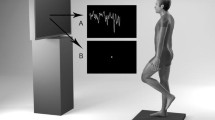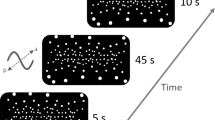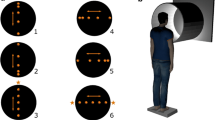Abstract
Fourteen healthy adults were tested to assess the potential influence on stance maintenance of two parts of the visual feedback technique (display scale and time delay). The task consisted in their kee** a spot on the screen representing their center of pressure, CoP (i.e. successive points of application of the ground reaction forces detected by the force platform on which they were standing) to a minimum size. The analysis focused on elementary motions computed from the complex CoP trajectories, that is the horizontal motion of the center of gravity (CoGh) and the difference between the CoP and the vertical projection of the center of gravity (CoP−CoGv). The former is recognized as the main variable in postural control, and several interesting features can be extracted from the latter. The results indicate that setting a delay and increasing the display scale induce substantial reductions in CoP−CoGv and CoGh displacements, respectively. Interestingly, when the two effects are combined, these single effects cohabit quite happily. Fractional Brownian motion modeling of these trajectories revealed clearly that, in each case, these effects originate principally from poor or improved control, respectively. This feature confirms that these elementary motions are involved differently in the postural system and that study of the complex CoP might not be of great interest. By generating opposing but complementary trends, the visual feedback technique should thus be perceived as a promising tool for inducing particular postural behavior in healthy and disabled individuals.





Similar content being viewed by others
References
Brenière Y (1996) Why we walk the way we do? J Mot Behav 28:291–298
Brenière Y, Do MC, Bouisset S (1987) Are dynamic phenomena prior to step** essential to walking? J Mot Behav 19:62–76
Caron O, Faure B, Brenière Y (1997) Estimating the center of gravity of the body on the basis of the center of pressure in standing posture. J Biomech 30:1169–1171
Caron O, Gélat T, Rougier P, Blanchi JP (2000) A comparative analysis of the centre of gravity and the centre of pressure sway paths in standing posture: an estimation of active stiffness. J Appl Biomech 16:234–247
Collins JJ, De Luca CJ (1993) Open-loop and closed-loop control of posture: a random-walk analysis of center of pressure trajectory. Exp Brain Res 95:308–318
Henneman E, Somjen G, Carpenter DO (1965) Functional significance of cell size in spinal motoneurons. J Neurophysiol 28:560–580
Horstmann A, Dietz V (1990) A basic posture control mechanism, the stabilization of the center of gravity. Electroencephalogr Clin Neurophysiol 76:165–176
Mandelbrot BB, Van Ness JW (1968) Fractional Brownian motions, fractional noises and applications. SIAM Rev 10:422–437
Rougier P (1999a) Influence of visual feedback on successive control mechanisms in upright stance in humans assessed by fractional Brownian motion modelling. Neurosci Lett 266:157–160
Rougier P (1999b) Automatic determination of the transition between successive control mechanisms in upright stance assessed by modelling of the centre of pressure. Arch Physiol Biochem 107:35–42
Rougier P (2003a) Visual feedback induces opposite effects on elementary centre of gravity and centre of pressure minus centre of gravity motions in undisturbed upright stance. Clin Biomech 18:341–349
Rougier P (2003b) The influence of having the eyelids open or closed on undisturbed postural control. Neurosci Res 47:73–83
Rougier P (2004) Optimising the visual feedback technique for improving upright stance maintenance by delaying its display: behavioural effects on healthy adults. Gait Posture 19:154–163
Rougier P, Caron O (2000) Center of gravity motions and ankle joint stiffness control in upright undisturbed stance modeled through a fractional Brownian motion framework. J Mot Behav 32(4):405–413
Rougier P, Farenc I (2000) Adaptative effects of loss of vision on upright undisturbed stance. Brain Res 871:165–174
Rougier P, Burdet C, Farenc I, Berger L (2001) How leaning backward or forward affects undisturbed stance control in humans. Neurosci Res 41(1):41–50
Rougier P, Farenc I, Berger L (2004) Modifying the gain of the visual feedback affects undisturbed upright stance control. Clin Biomech 19:858–867
Tagaki A, Fujimara E, Suehiro S (1985) A new method of statokinesigram area measurement: application of a statistically calculated ellipse. In: Igarashi M, Black O (eds) Vestibular and visual control on posture and locomotor equilibrium. Karger, Basel/Suisse, pp 74–79
Weinstein S (1968) Intensive and extensive aspects of tactile sensitivity as a function of body part, sex, and laterality. In: Kenshalo DR (ed) The skin senses. Thomas, Springfield IL USA, pp 195–222
Winter DA, Patla AE, Prince F, Ishac M, Gielo-Perczak K (1998) Stiffness control of balance in quiet standing. J Neurophysiol 80:1211–1221
Acknowledgments
The author is pleased to acknowledge D. Goodhew for correction of the English text and the referees for their helpful comments
Author information
Authors and Affiliations
Corresponding author
Rights and permissions
About this article
Cite this article
Rougier, P. Compatibility of postural behavior induced by two aspects of visual feedback: time delay and scale display. Exp Brain Res 165, 193–202 (2005). https://doi.org/10.1007/s00221-005-2288-8
Received:
Accepted:
Published:
Issue Date:
DOI: https://doi.org/10.1007/s00221-005-2288-8




